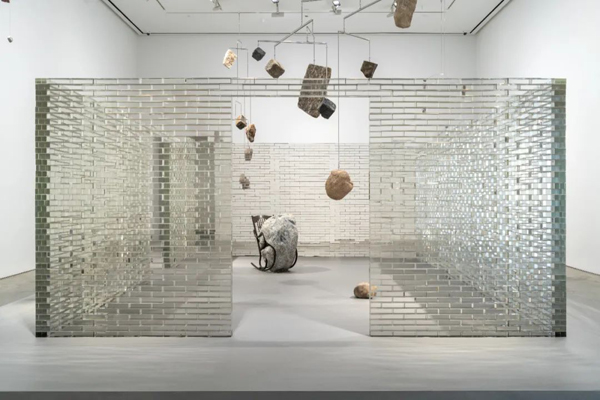
Installation views: Alicja Kwade, Petrichor, 303 Gallery, New York, 2022. Photo: Justin Craun. Courtesy 303 Gallery, New York
With the poet’s state of mind, the natural freshness of the vacant valley after the early autumn rain is “the empty mountains after fresh rain,” while the eternally dry soil suddenly encounters a timely rain, which falls in the poem then becomes the “desired rain after a long drought.” In 1964, two Australian researchers named the unique earthy smell from this natural phenomenon “Petrichor.” An exhibition of the same name and similar to this “state” and “smell” is Alicja Kwade: Petrichor at 303 Gallery in New York. “Petrichor” comes from “ancient Greek and its prefix refers to ‘rock’ or ‘stone,’” a common material in the works of Polish-German artist Alicja Kwade; among other objects are wood, copper, and glass. Kwade’s concept of art suspended above multiple disciplines allows them to take on a non-fixed pattern and transcendent form, and envelops them in an implicit atmosphere that mobilizes the viewer to question the perception of reality.
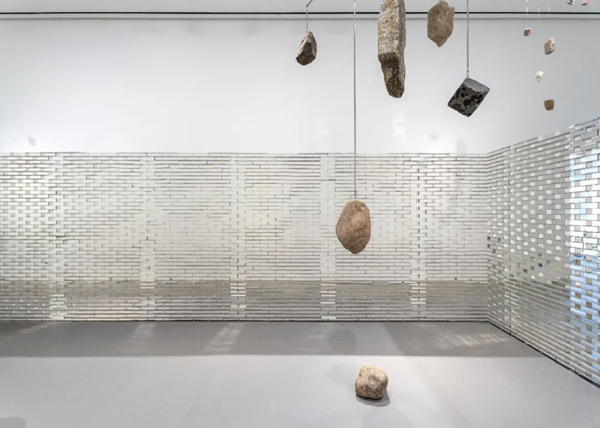
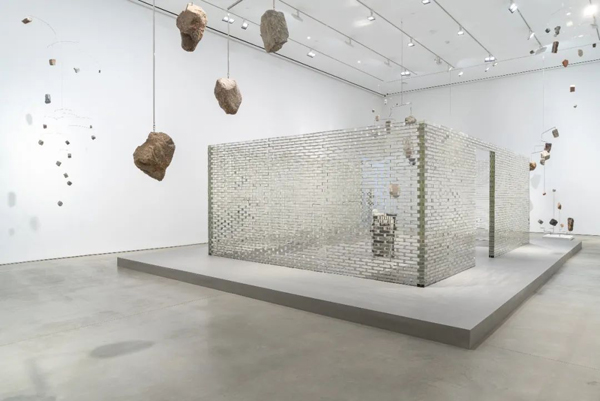
Installation views: Alicja Kwade, Petrichor, 303 Gallery, New York, 2022. Photo: Justin Craun. Courtesy 303 Gallery, New York
An immersive installation located in the center of the gallery, Glass House (2022) congeals a static and unrivaled force that significantly extends the material’s properties and visual appeal. The glass bricks present a kind of igloo texture, which inevitably flashes back to Allan Kaprow’s rectangular enclosures of ice blocks, yet the house is a replica of Kwade’s one room; set against the floating stones, it seems to have the magic of freezing time, space, and the people around it. Transparent glass bricks appear strong and powerful in layers, altering their perceived fragility. Reflected by light, it casts crystalline light and shade that mirrors the artist’s contemplation and imagination of the material. One’s thinking mechanism is activated by encountering Stella Sella (2022), a bronze chair with a boulder, which subsequently elicits an anthropomorphic literary allegory: a silent old man sitting in a chair who is accepting the passage of time or a person who is tired of increasing toil. The house becomes a reference to the contemporary in this context: we live in a world like Truman’s or a data age where information is highly dense and transparent. The balance of forces creates a literary context and changes our habitual vision and thinking. Those seemingly tough objects that have incompatible properties become one in a relatively rational way.
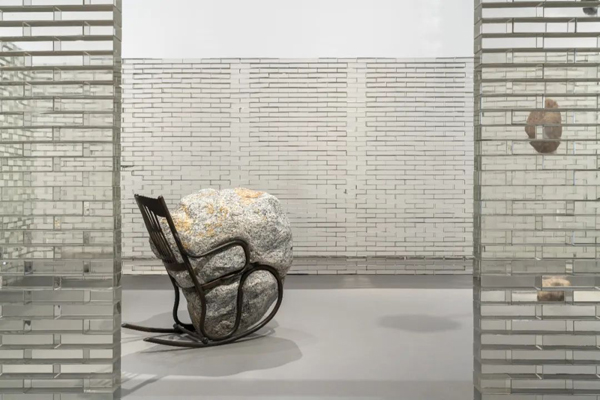
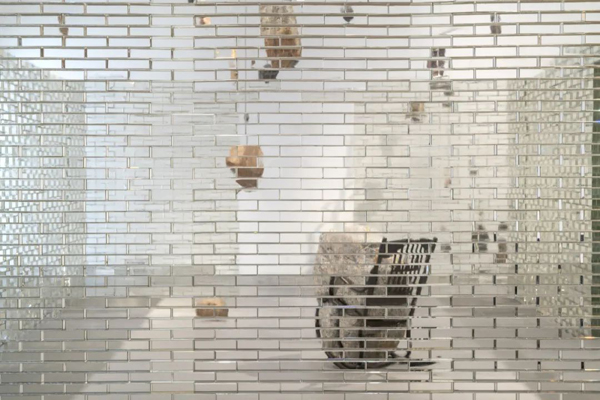
Installation views: Alicja Kwade, Petrichor, 303 Gallery, New York, 2022. Photo: Justin Craun. Courtesy 303 Gallery, New York
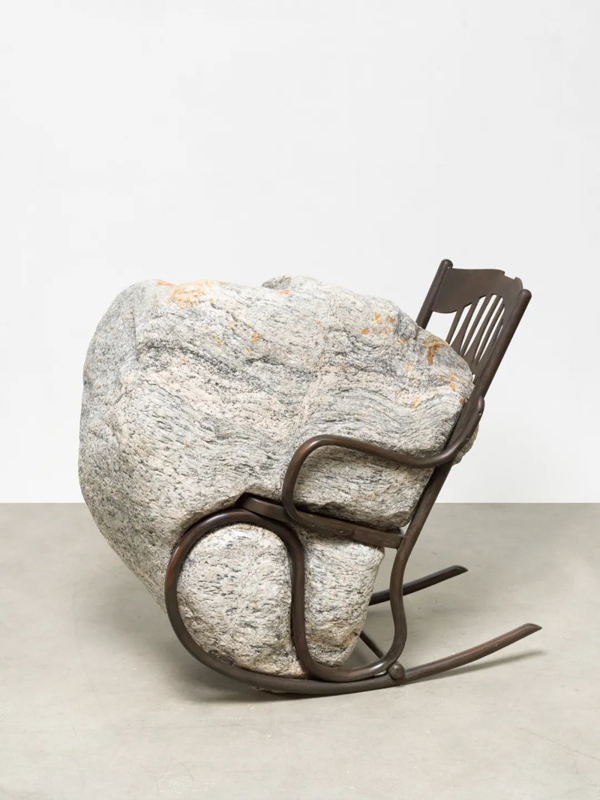
“Stella Sella”, 2022, bronze, stones, 38 5/8 × 19.69 × 39.76 inches (98×50×101cm). Photo: Roman Marz. Courtesy 303 Gallery, New York
Kwade’s adherence to the principles of mechanics is inseparable from the consideration of the intrinsic nature of matter. Rocks of varying sizes and shapes collide with stainless steel in a subtle confrontation and balance between fine and rough, light and bulky. Fixed at the top, they have a serene posture for observation or are suspended from either side, creating rational beauty and lyrical meaning. Their natural colors play an unexpected role. Dark gray, light gray, beige, orange-red, and brown produce abstract images of different shades within the laws of physics. Suspended mobiles like Heavy Skies (2022) move towards a similar form to Alexander Calder’s abstract sculptures. Physical light works well again in a way that paints those stones with gray silhouettes, like dancing puppets or black jewels dotting the day. “Each element leaves an individual wake behind its individual self,” Calder has said. The suspended stones cryptically indicate orbiting planets or particles. Looking up, they are being kept still because of their weight, revealing a philosophical form - a thinking Reed.
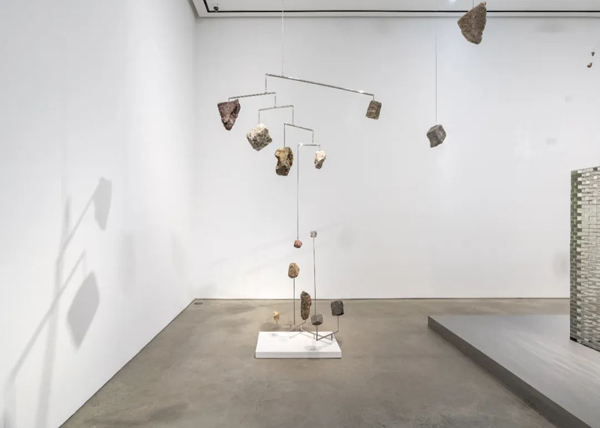
Installation views: Alicja Kwade, Petrichor, 303 Gallery, New York, 2022. Photo: Justin Craun. Courtesy 303 Gallery, New York
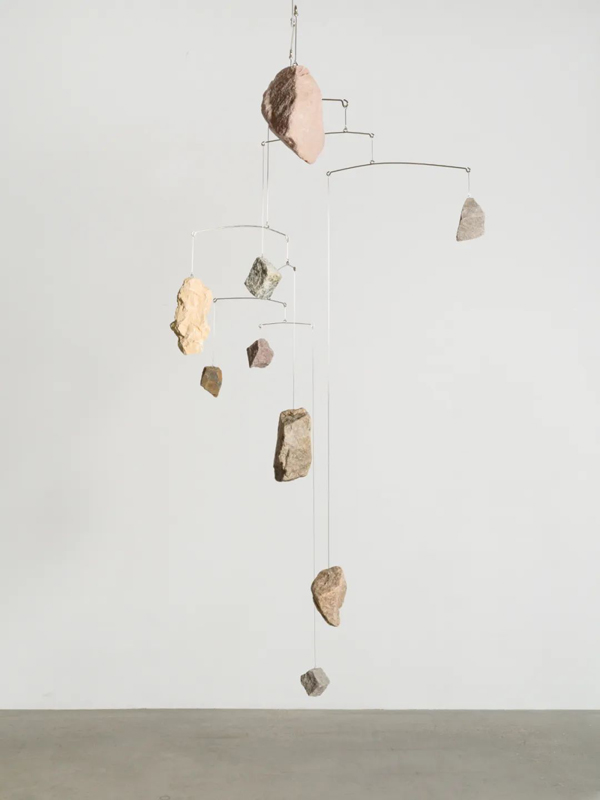
Heavy Skies, 2022, spring steel, silver-coated, mirror polished, stones, 90 1/2 × 33 1/2 × 27 1/2 inches (230×85×70cm). Photo: Roman Marz. Courtesy 303 Gallery, New York
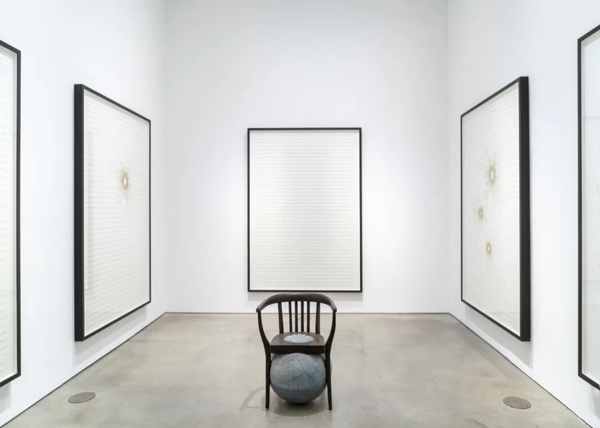
Installation views: Alicja Kwade, Petrichor, 303 Gallery, New York, 2022. Photo: Justin Craun. Courtesy 303 Gallery, New York
One’s unfulfilled desire to wander outside the Glass House will be satisfied in another physical space that induces an isolated field. Greeted by the Siège du Monde (2022), composed of a bronze chair and azure macaubas, the form differences and rhetorical devices between materials constitute the conceptual contexts of movement and stillness. The blue marble has an astral connotation, as in the sculpture ParaPivot exhibited in 2019 at the Roof Garden of The Metropolitan Museum of Art in New York. The chair is deconstructed in the vastness of the universe, wandering freely and alone, echoing the saying of Kwade, “Sometimes I enjoy sitting on a chair on the earth surrounded by universes.” The wonderful realm of man is revealed in these words. Made up of a diverse variety of cells, we are also stardust itself, and the universe inhabits us. Rather than exist independently, the object bearing the “universe” is surrounded by “time,” five groups of 8,760 watch hands. They express natural trends regarding entropy in an ordered and disordered state. In One Year I (2022), each group of five watch hands points in a different direction, and they cross each other to form an undulating line. In the rest of the wall works, these watch hands become more chaotic as they move closer to the center, eventually clustering into a circle impact pattern. As if ants crawled across the ground at a subtle speed to build the center of their nest.
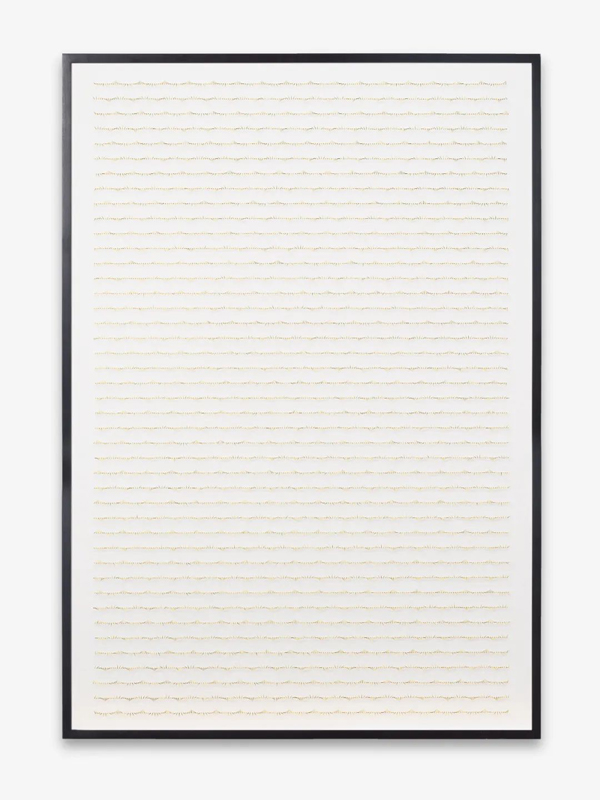
One Year I, 2022, watch hands on cardboard, 85 × 58 5/8 × 2 inches (216×149×5cm) framed. Photo: Roman Marz. Courtesy 303 Gallery, New York
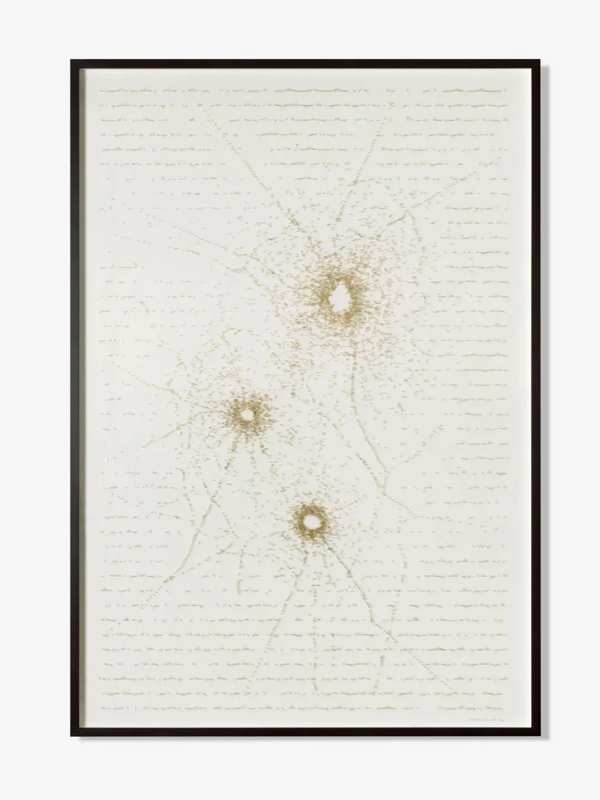
One Year IV, 2022, watch hands on cardboard, 85 × 58 5/8 × 2 inches (216×149×5cm) framed. Photo: Roman Marz. Courtesy 303 Gallery, New York
Tens of thousands of watch hands are precisely calculated and arranged in a manner that cannot be separated from the artist’s subjective time experience and mental calculations. Whether it is an hour or a year, it is a standard or concept in a system of rules and symbolic meanings established by humans. Kwade’s involvement with time is also connected to an understanding of semiotics. Time itself is intangible, like the term “Petrichor,” and ingrained in our cognitive field through the theoretical shaping of different sciences. As a higher physical dimension or an observable phenomenon, it exists objectively and is constantly changing. Kwade is not bewildered by the discernment of time but merely sees it as a form of measurement--length as a method of timing and a year in hours--neither romanticizing nor emphasizing its specificity. Being immersed in this set of measurement rules she had developed unexpectedly made me briefly forget that I was in the present. As sunset approached, my mind wandered to Jorge Luis Borges’s poem, “Only life exists. Its forms are space and time, they are magical instruments of the soul.”
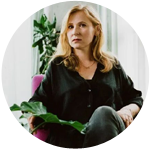
Alicja Kwade was born in 1979 in Katowice, Poland; she currently lives and works in Berlin. Recent exhibitions include solo shows at Berlinische Galerie, Berlin; Langen Foundation, Neuss, Germany; MIT List Visual Arts Center, Cambridge; Dallas Contemporary; Centre de Création Contemporaine Olivier Debré, Tours; Blueproject Foundation, Barcelona; ESPOO Museum of Modern Art; Kunsthal Charlottenborg, Copenhagen; Fondazione Giuliani, Rome; Museum Haus Konstruktiv, Zurich; YUZ Museum, Shanghai; de Appel Arts Centre, Amsterdam; Kunsthalle Nürnberg; Kunsthalle Schirn Frankfurt/Main; Haus am Waldsee Berlin; and on the occasion of the award ceremony of the Hectorpreis 2015, at Kunsthalle Mannheim. She has been included in group exhibitions at the Hayward Gallery, London; 57th Venice Biennale; Madam, Luxembourg; Bass Museum of Art, Miami Beach; Kunsthalle Wien; Museum of Contemporary Art Detroit; and CCA Wattis Institute, San Francisco. She was the recipient of the Metropolitan Museum of Art’s 2019 Roof Garden Commission. In 2015-2016, Public Art Fund commissioned “Against the Run,” an installation in New York’s Central Park. Her works belong to many important international private and public collections.


